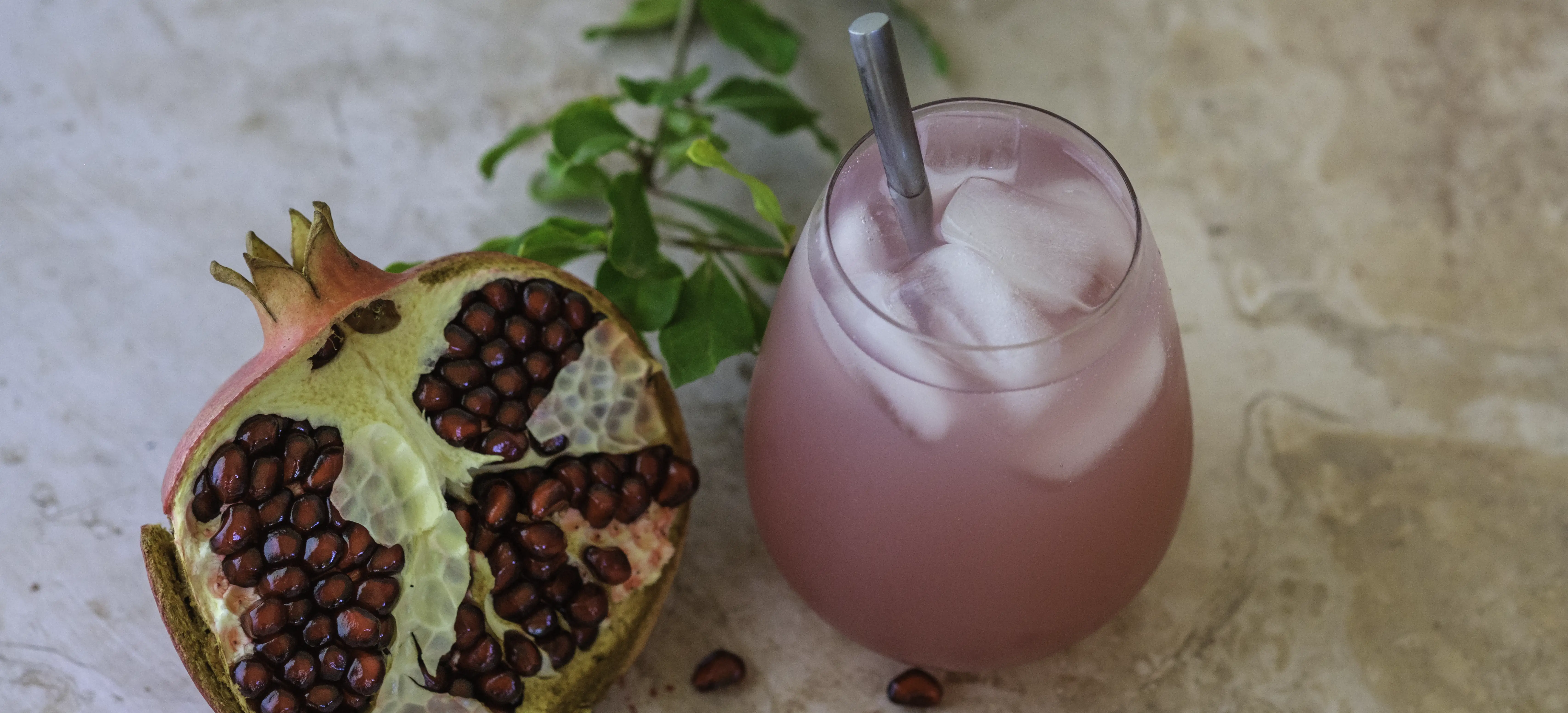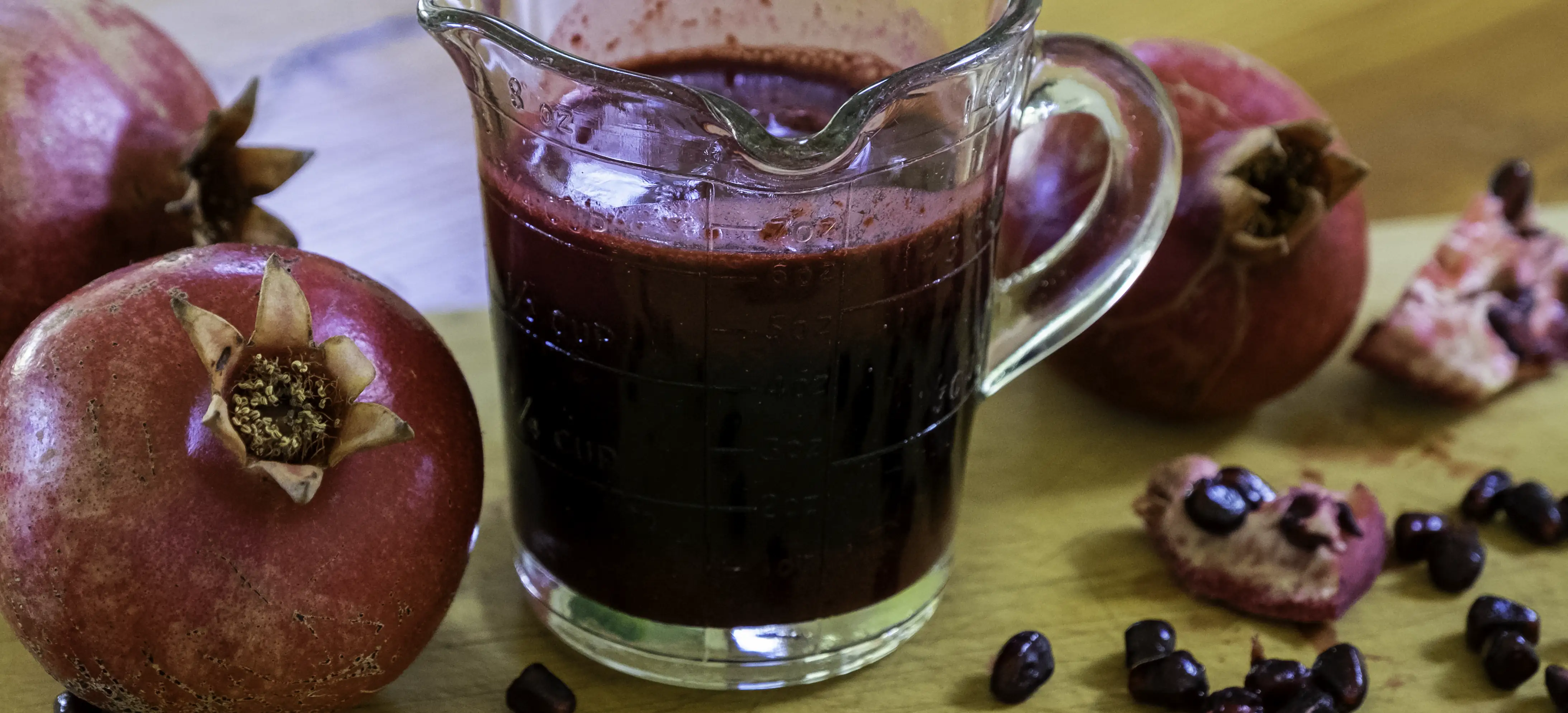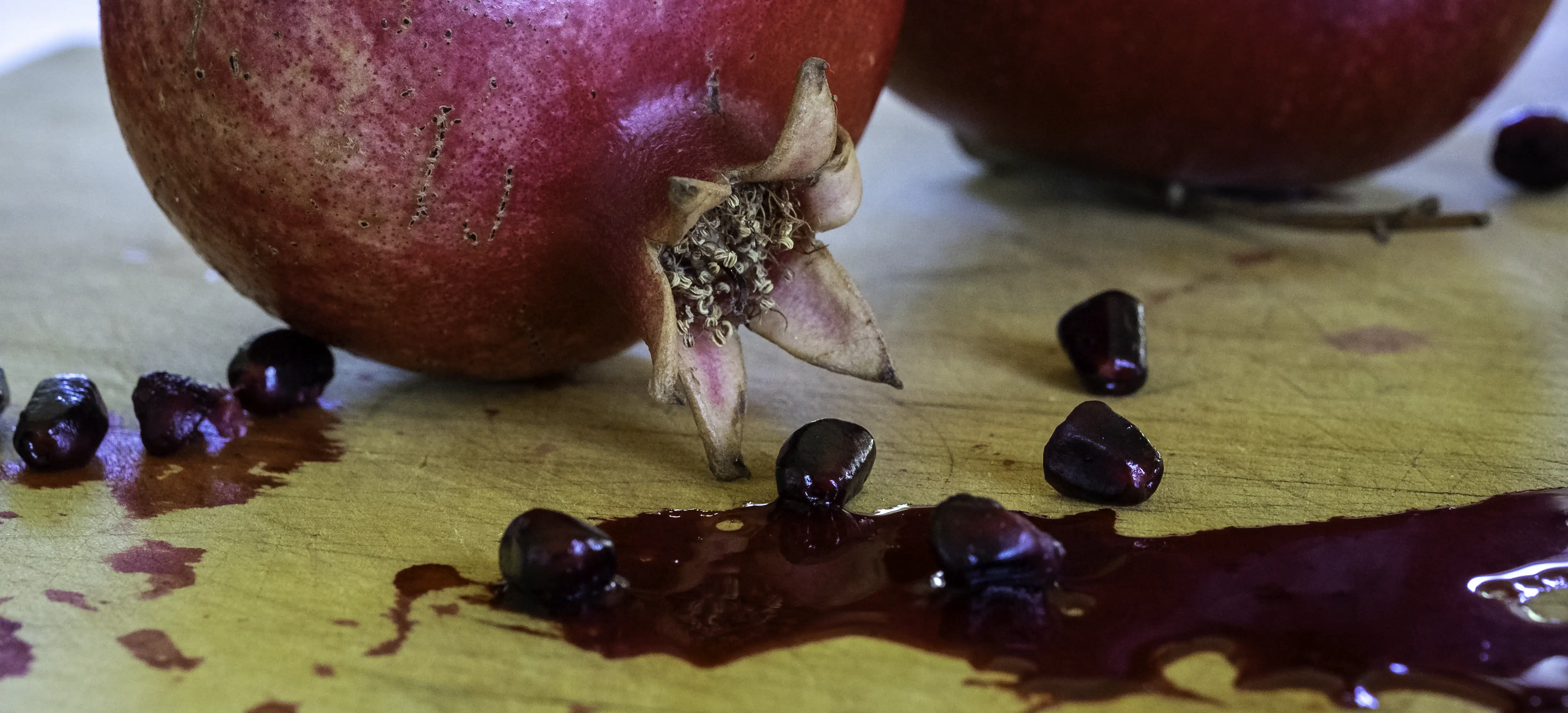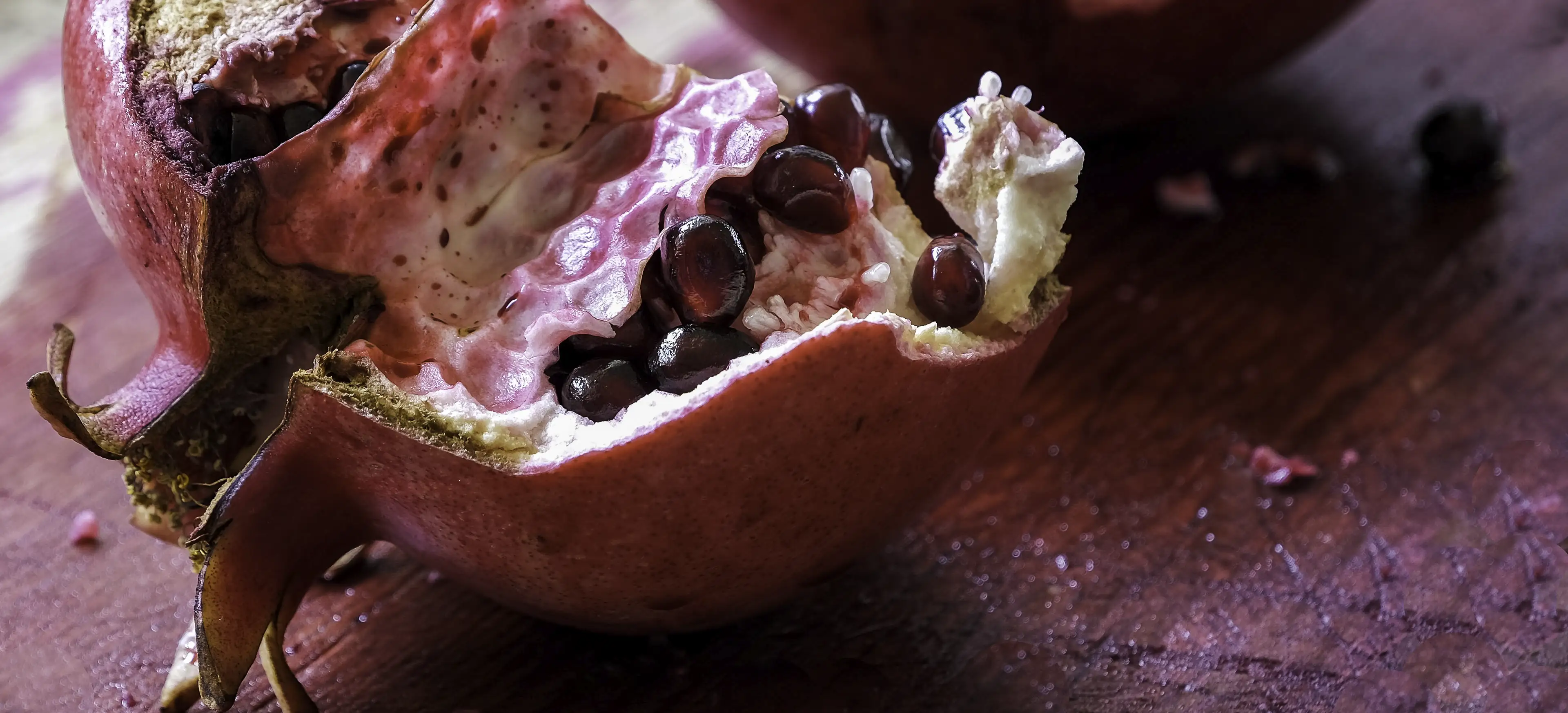Grenadine
- Cordials, Syrups & Sweet Sauces

Grenadine, made from pomegranates, provides a refreshingly complex melange of flavour and nutrients all bound together in its distinctive deep crimson coloured juice. It’s simple to make with most of the time being taken to de-seed and juice the pomegranates. But once that’s done, it’s as simple as adding some sugar and let it simmer away quietly on the stove. Grenadine gets its name from the early French word for pomegranate – grenade. During the 1880s it made its mark in French cafes as a water sweetener. Soon its popularity caught on and spread through America where progressively an artificial version took hold. With the renewed interest in using fresh seasonal produce, and the use of authentic products, the ‘real” grenadine has returned to many retailers. While pomegranates are abundant, make your own to use throughout the year as a freshly sweet-tart cordial.
- Preparation Time:
- 45 minutes
- Cooking Time:
- 20 minutes
- Quantity:
- 2 x 375 ml bottles
PREPARATION
Sterilise glass jars and lids that have a protective lining. Have the jars and lids dry, hot and ready for the bottling stage. Here’s my quick reference guide to sterilising containers.

INGREDIENTS
- 650 ml
- Pomegranate juice
- 500g
- Sugar, white
METHOD
There are several different methods of removing the seeds (arils), find the one that works best for you. My fav method is provided in the recipe.
The pomegranate juice is made in two stages: (1) removing the seeds (avils) from the fruit and then (2) juicing the seeds.
To prepare the pomegranate juice, horizontally cut 8-10 large pomegranates in half. Holding the cut half on one hand over a sink or large bowl of water, use the back of a large spoon, mallet or similar kitchen utensil to hit the outside skin of the pomegranate to release the seeds. They will sink to the bottom of the container, while any white membrane, that may come away, will float. Repeat this process until all the seeds have been extracted.
Using a fine strainer or sieve, scoop up the membranes and discard. Be prepared for some stray pomegranate seeds and/or juice. It temporarily stains indiscriminately, aprons, the floor, fingernails and whatever it comes in contact with. Fortunately, it can be removed with strong detergents.
Place the seeds in a juicer and process until all seeds have released their juice. Refer to my Notes Section below Juicing Pomegranates, if required, on how to juice the seeds. Discard the pulpy seed mass and measure the amount of juice obtained.
Place the juice in a stainless-steel preserving pan or heavy bottom stainless steel pot. For every 250ml strained juice, add 180-200g sugar, depending on your taste. Simmer, stirring occasionally to ensure all the sugar has dissolved. Bring it to the boil and then return it to a simmer for 10 minutes. Remove any scum that floats to the surface. Refer to my Notes Section below: Removing the Scum, if required. This will help to keep the cordial clear.
Remove from the heat and allow to rest for a few minutes. Use a funnel to pour into hot dry sterilised screw cap sealable bottles, fill to approximately 2.5cm (1 inch) from the top of the jar and seal immediately with hot dry lids. This is the HHH method of sealing - hot preserve, hot jar with a hot lid. Refer to the Notes Section below: The HHH Method, for further information.
Allow to cool and wipe the jars down to remove any spills during the bottling stage, then label.
Store in the fridge. It is recommended to use within 3-4 weeks.
For a longer-term storage solution, process the bottles in a Hot Water Bath. Refer to my Notes Section below: Hot Water Bath Processing, if required. Once these bottles have been opened, store in the fridge.
NOTES

- Good quality jars should be used in all preserving, particularly when they are processed in a hot water bath. Thin jars often cannot withstand the temperatures and may crack either in the bath or on and or after removal. Avoid the disappointment and invest in some good jars from a homewares or preserves outlet. Select jars that have non-reactive lids as vinegar-based solutions can cause the lids to rust over time.
- Cooking times are an approximation only. They are provided as guidelines as cooking times are influenced by the type of pot and its diameter and height, speed of cooking and fruit ripeness, size, and moisture level.
- Juicing Pomegranates
- I use a Kuvings cold press juicer to make pomegranate juice. This wonderful machine extracts juice by squeezing and pressing ingredients. Using low-speed cold press technology preserves the enzymes of the fruit. The nutrient load of the juice remains intact, and the seeds are not mashed which contributes to a bitter flavour, plus there’s no additional straining to separate the juice from the mashed seed mass.
- To make pomegranate juice, first deseed the pomegranates and then process the seeds. A juicer is the preferred method of extracting the juice as a food processor or blender will mash the seeds. This pulpy mass will need to be strained overnight to extract the juice. Care must be taken not to overprocess the seeds as they can leave a coarse bitter flavour to the juice.
- Removing the Scum
- Preserving fruit and fruit-based juices can produce a scum while they are boiling. Impurities from the fruit and sugar will rise to the surface and a fine frothy foam will move towards the edge of the preserving pan. Some fruits will produce more scum than others.
- This is a natural self-clarification process and makes the task of making a high-quality preserve easier. Removing the scum increases the preserve’s clarity. This is very important if it is being submitted for competition.
- Remove the scum before bottling. Using a stainless-steel spoon, skim the scum from around the edge of the preserving pan. Be careful to remove just the scum and not the jam.
- This can be done while the preserve is boiling and/or once it has been taken off the heat. Do not attempt to remove the scum from the centre of a boiling pan, as there is a high risk it will splutter and hot preserve burns.
- The HHH method of HOT dry jars, HOT dry lids and HOT preserve creates a vacuum seal as it cools. The “popping” sound, often heard in the kitchen, signals a successfully vacuum sealed jar. This method of sealing is preferred as there is reduced risk of contamination prior to and after sealing.
- Hot Water Bath Processing
- Processing preserves in a hot water bath creates a vacuum seal and increases the products shelf-life and quality. Either of the following methods provides an easy and safe solution in a home kitchen
- Preserving Unit Method
- Place sealed bottles in a Fowlers Preserving Unitor equivalent
- Each unit is likely to have their own recommended process. Please follow the appropriate process for your unit.
- The following method is for the Fowlers Vacola Simple Natural/Year Rounder unit.
- Cover the sealed bottle/s with water and set the kitchen timer to 1 hour. Switch off after one hour.
- The water should not boil. If boiling does occur within the hour, do not allow to boil for longer than 5 minutes. Turn off unit and remove the lid.
- Using the tap, draw off some hot water so the level is sufficiently below the bottles to be able to safely remove them without scalding yourself.
- Remove from the hot water bath and place on a board to cool for 12-18 hrs before removing the lids. If a vacuum seal has not been created. Process a second time.
- Stock Pot Method
- Line large stock pot with some sheets of newspaper or a cut-down cake rack. Place the bottles on the newspaper or rack, in the pot, allowing space between each bottle so they do not touch. This lining will protect the bottles from direct heat and prevent cracking.
- Cover the preserves with water which is the same temperature as the preserves. Bring to the boil and hold at gentle boil for 30 minutes.
- Turn off, remove lid, and allow to stand for 5 minutes before removing.
- If possible, remove some of the hot water so the level is sufficiently below the bottles to be able to safely remove them without scalding yourself.
- Remove from hot water bath and place on a board to cool.
- How to Use Grenadine
- Make a refreshing cordial. Add ice cubes to a tall tumbler, add a good splash of grenadine to suit your taste and top with fresh water, sparkling or mineral water.
- Add to cocktails and Mocktails. Some of the most famous cocktails that use grenadine are: Tequila Sunrise, Shirley Temple, Caribbean Rum Punch and Pomegranate Daiquiri. And there are many more ...
- Variations: To make an alcoholic version, for every ½ litre (2 cups) of prepared grenadine, add in 30 ml of pure vodka. Mix and bottle. The alcohol will also act as a preservative after the bottle has been opened.

